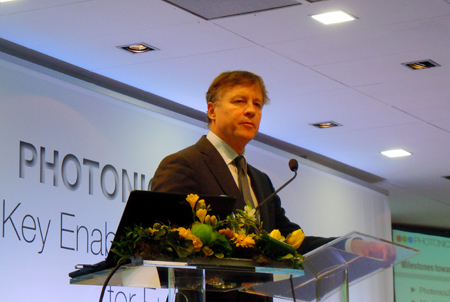18 Apr 2012
Panel discussion at Photonics21's annual meeting considers how to boost photonics sector prospects.
The European photonics industry is ready to deliver on its commitment of an overall investment of 7 Billion Euros in a Photonics Public Private Partnership (PPP) by 2020 and make an impact on creating new jobs and recovering from the economic crisis. This was a key conclusion of a panel discussion at the annual meeting of Photonics 21, the pan-European photonics association.Panel speaker and MEP Malcolm Harbour expressed his support for a Photonics PPP: “Photonics is recognized as a critical strategic technology for a modern and technologically advanced Europe. The proposed 7 Billion Euro partnership between Photonics21 and the European Commission would have a substantial impact on future growth and job creation, and significantly assist the EU’s continued economic recovery. It will be a major boost for the Innovation Union".
Martin Goetzeler, the outgoing President of Photonics21, said, “Photonics21 welcomes the ambitious Horizon 2020 proposal by the European Commission with its approach for a real innovation focused funding with positive impact on jobs and competitiveness and where public private partnerships (PPPs) would generate a long term budget security for project partners.”
The panel agreed that the potential of the photonics industry, as in many other sectors, is currently limited by the so called “Valley of Death” in the innovation value chain. This dramatic phrase describes the difficult evolutionary stage between product R&D and achieving an established market position. “Photonics innovation in Europe tends to fall through in the stage between successful science and pilot scale industrial deployments, the latter being the stage at which jobs can start being created,” Goetzeler added.
”In order to strengthen Europe’s innovation capacity and capture the full benefit of Europe’s industry base, we need to avoid mistakes of the past and ensure the creation of an environment that nurtures innovation and covers the entire value chain, from the breakthrough in research through to the development of products.”
Dr. Zoran Stančič, Deputy Director-General of DG INFSO at the European Commission underlined at the Panel discussion that “Europe needs to face up to the challenges of a rapidly globalising economy. The photonics sector can unleash massive economic potential and help deliver the Digital Agenda for Europe. EU policies that support research, demonstration, and application are crucial for spurring Europe’s competitiveness.”
Panel highlights
Moderator Jackie Meade: What do you believe are the key drivers for photonics innovation, and what are the key issues we need to address?
Malcolm Harbour: For me the issue is not so much about generating innovation, photonics has demonstrated that it has the ideas, but the big issue is how we develop that innovation into new products and services, new business, wealth generation, employment and globally-dominating wealth centers. The photonics industry is a real demonstrator for many other industries as how to transfer innovation.
Zoran Stančič: We need to take a holistic view. We have to have a proper environment – people with the proper skills with engineering. Europe needs to face up to the challenges of a rapidly globalising economy. The photonics sector can unleash massive economic potential and help deliver the Digital Agenda for Europe. EU policies that support research, demonstration, and application are crucial for spurring Europe’s competitiveness.”
Jackie Meade: Zoran Stančič mentioned the need for an innovation-friendly environment. So Gorgio, what do you think are the key elements of an innovation-friendly environment and what do you want from Zoran?
Giorgio Anania: Today, we have the expectation that the industry is basically competitive – this is a must in order for us to survive – so that innovation is our lifeblood. In order to be successful, when you are looking at Europe, we are in competition with other regions. What we also expect is that the competitors on the volumes we have this is something which concerns all of us involved in research-to-innovation with countries with like China and Japan.

Giorgio Anania: Photonics 21 panelist.
In Europe we don’t have a market that is suitable for technology innovation. Technology needs to be able to move up down sideways etc but we have a slow-moving structure. So I have a couple of messages: one is invest in photonics and two is that the market needs to evolve. Look at China: China is not competitive because it is cheaper, China is competitive because it is quicker.
Malcolm Harbour: I agree about the balance of funding; we do need to shift funding towards the knowledge transfer stage. Remember that Horizon 2020 is with the European Parliament at the moment, so you need to make that point to my European Parliamentary colleagues: The broader question is that while the business environment is pan-European and beyond, financial and tax incentives for R&D across Europe are actually more to do with the policies of individual member states. The European Parliament needs to encourage prime ministers to make their countries more photonics-friendly.
Martin Goetzeler: I also wish to reiterate the importance of effective market competition not so much within Europe but between Europe and the other key global areas. And in Europe, public procurement is key to the continued growth of the photonics sector.
Giorgio Anania: I would like to violently agree with the idea of encouraging public procurement of photonics-based technologies . In China, for example, the government decided that public procurement of new street lighting would focus on LED-based systems; that kind of decision has impact on the whole value chain.
Malcolm Harbour: On the table of my committee at the moment is a major reform of public procurement including an entirely new instrument to encourage the adoption of innovation. All we need is your support.

Martin Goetzeler, the outgoing President of Photonics21.
Concluding remarks
Giorgio Anania: For me the key to photonics sector success depends on pump priming. If you have effective public procurement policy then the value chain will organize itself.
Malcolm Harbour: A significant step will be sorting out a public procurement regime and I would like to work with the Photonics PPP to achieve that. Secondly I think it would be helpful to establish a pan-European photonics focused venture capital fund that could operate all over the continent.
Zoran Stančič: We need to work on revising funding instruments and regulations to achieve more in the funding sector; we also need to improve our outreach to small companies and SMEs.
Martin Goetzeler: In short we need to improve the speed of all the processes around European photonics business development.
About the Author
Matthew Peach is a contributing editor to Optics.org
| © 2024 SPIE Europe |
|